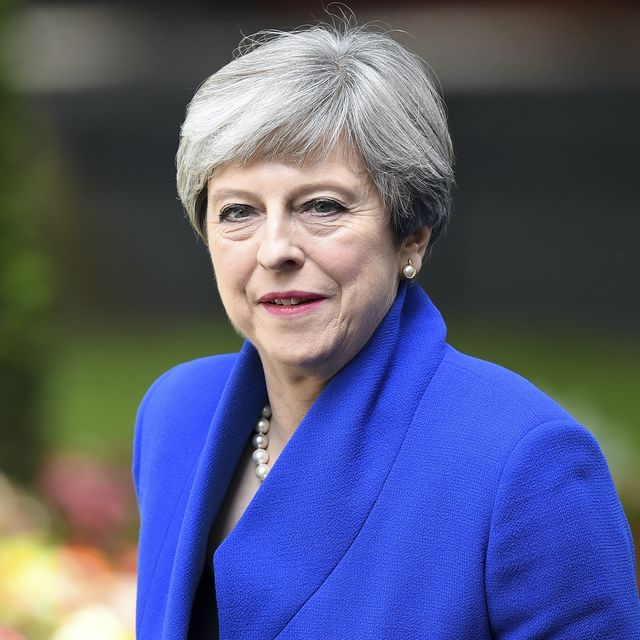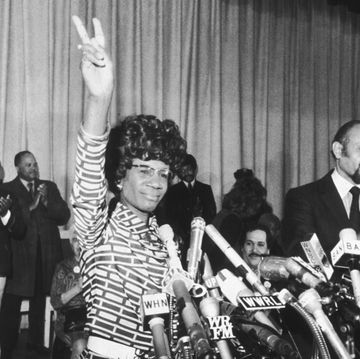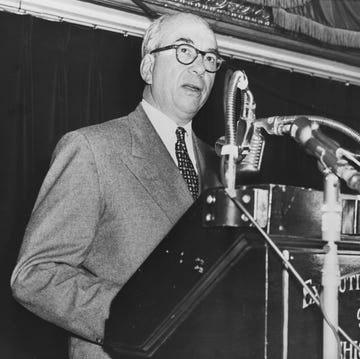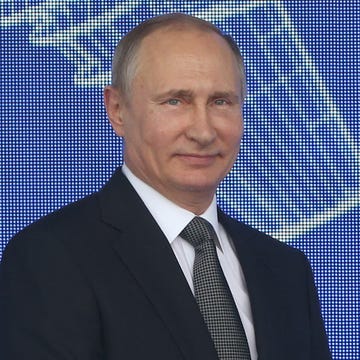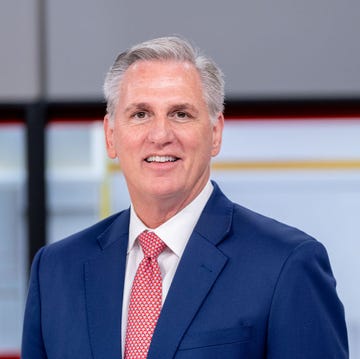(1956-)
Who Is Theresa May?
Following the resignation of David Cameron, Theresa May became Britain's first female Prime Minister since Margaret Thatcher and the first tasked to lead the country out of the European Union after its historic Brexit referendum, which was held in June 2016. She held the post until stepping down in July 2019. A member of the Conservative Party, May had originally voted to stay in the E.U., despite having reservations. Previously, she was appointed Home Secretary in 2010 and was elected MP (Member of Parliament) of Maidenhead in 1997.
Early Life and Career
Theresa Mary May was born on October 1, 1956 in Eastbourne, Sussex. Her father was a vicar for the Church of England and her mother was a housewife. May attended state-run primary and grammar schools and briefly went to Catholic school. She studied geography at St. Hugh's College at Oxford University and earned her B.A. in 1977. It was during this time she had met her husband Phillip May and the two married in 1980.
After graduation, May spent the next 20 years working in the financial sector before making her way into the education and political sectors in the mid 1980s and '90s. She was elected as Conservative MP (Member of Parliament) of Maidenhead in 1997, describing herself as a "One-Nation Conservative."
Political Career
In 2002 May was appointed as the first female Chairman of the Conservative Party and was famously quoted as saying it must no longer be known as the "Nasty Party." She served in a number of Shadow Cabinets before becoming Home Secretary in 2010, and also became the Minister for Women and Equalities, a post she vacated in 2012.
As the longest-serving Home Secretary in six decades, she was known for her work on police reform and pursuing stricter drug and immigration policies.
Brexit and PM Candidacy
To the shock of the world and to almost half of its own citizens, the U.K. voted to exit the European Union in June 2016 — an event which is referred to as the "Brexit" (Britain Exit) referendum. (May originally voted to remain in the E.U., although she was known to be a "Euroskeptic.")
After Prime Minister David Cameron announced his resignation, May announced her candidacy for the Conservative Party and quickly emerged as its frontrunner, receiving 50 percent of the Parliamentary votes alone amid the other candidates. On July 7, 2016, it appeared that she and fellow Conservative leader Andrea Leadsom would both be in contention to become the country's next PM, but within days, Leadsom, who voted for Britain to leave the E.U., pulled out of the running due to distasteful remarks she made about why she would make a better PM.
With no one contesting her candidacy, May was set to be sworn in as the first post-Brexit female Prime Minister. On July 11, 2016, she made a televised announcement surrounded by Members of Parliament and her husband Philip, about seeing Brexit through:
"During this campaign, my case has been based on three things. First, the need for strong, proven leadership to steer us through what will be difficult and uncertain economic and political times. The need, of course, to negotiate the best deal for Britain in leaving the E.U. and to forge a new role for ourselves in the world. Brexit means Brexit. And we are going to make a success of it."
May continued: "Second, we need to unite our country. And third, we need a strong, new positive vision for the future of our country. A vision of a country that works, not for the privileged few, but that works for every one of us. Because we’re going to give people more control over their lives. And that’s how, together, we will build a better Britain.’"
Prime Minister
May was sworn in as Britain's second female Prime Minister on July 13, 2016, and the Queen's 13th Prime Minister following ceremonial overtures.
On May 29, 2017, Prime Minister May officially told Parliament that she had invoked Article 50 of the Lisbon Treaty, legislation triggering the legal process to set Brexit in motion. "This is an historic moment from which there can be no turning back. Britain is leaving the European Union,” she said. “We are going to make our own decisions and our own laws. ... We are going to take control of the things that matter most to us. And we are going to take this opportunity to build a stronger, fairer Britain — a country that our children and grandchildren are proud to call home."
The United Kingdom’s ambassador to the European Union, Tim Barrow, delivered a letter to European Council President Donald Tusk, notifying the E.U. that the U.K. was leaving the union.
Shortly afterward, on June 8, an early general election resulted in the loss of her Conservative Party's Parliamentary majority. In November, the PM faced additional troubles with the resignation of two cabinet ministers — Secretary of State for International Development Priti Patel and Secretary of State for Defence Sir Michael Fallon — in the span of seven days. The shake-up was reported to have sparked concern that the Conservative Party was headed for further disarray, including a possible change in leadership.
In early December, a report surfaced that MI5, the British domestic intelligence agency, had foiled a terrorist plot to assassinate May. According to the report, two men were planning to use improvised explosives to blow up the gate at the prime minister's residence and to kill her in the ensuing chaos. The two suspects were arrested in late November.
Brexit Setbacks
On December 13, May suffered another setback in the ongoing Brexit process. After requesting maximum leeway to negotiate with E.U. leaders over terms of departure, Parliament rejected her request by voting that any final deal to withdraw be submitted via legislation. As a result, the prime minister was viewed to have diminished leverage heading into her discussions with the E.U.
Having previously butted heads with Donald Trump, May sought to present a more unified front with the American president when the two met at the World Economic Form in Davos, Switzerland, in January 2018. Following Trump's praise of their "great relationship," May cited the importance of maintaining a strong alliance. "We face the same challenges across the world, and as you say we’re willing to go and to defeat those challenges and meet them," she said.
In early February, May was set to chair the first of two Brexit meetings with senior ministers to outline the parameters of a relationship between the U.K. and E.U. With businesses applying pressure on the government to provide a clear strategy, the cabinet aimed to hash out differences on whether to go for a "clean" separation and strike new trade deals, or to retain close access to the single market.
By March, the PM had backed off on some of her Brexit demands, as the two sides outlined a provisional agreement in which the U.K. would retain the benefits of the single market and customs union, with Northern Ireland remaining under E.U. law to avoid a hard border with the Republic of Ireland. The provisional agreement was to end on December 31, 2020.
In June, Downing Street published detailed plans for a "temporary customs arrangement" that would align the U.K. with the E.U. customs union for one year should both sides fail to reach a customs agreement by the end of 2020. May reportedly agreed to the conditions after Brexit Secretary David Davis threatened to resign over the lack of a time limit for the so-called "backstop" proposal.
Historic Defeat
On January 15, 2019, just 10 weeks before Britain was scheduled to leave the bloc, May suffered a historic defeat in Parliament, where lawmakers rejected her proposed Brexit deal by a vote of 432 to 202. With no clear path to resolve the issue, Labour Party leader Jeremy Corbyn declared that he was offering a motion of no confidence in May's government.
May subsequently addressed the MPs: "It is clear that the House does not support this deal," she said. "But tonight's vote tells us nothing about what it does support. Nothing about how — or even if —it intends to honor the decision the British people took in a referendum Parliament decided to hold.
"If the House confirms its confidence in this government I will then hold meetings with my colleagues, our confidence and supply partner the DUP and senior parliamentarians from across the House to identify what would be required to secure the backing of the House," she continued. "The government will approach these meetings in a constructive spirit, but given the urgent need to make progress, we must focus on ideas that are genuinely negotiable and have sufficient support in this House."
Following more setbacks in Parliament, May in late March reportedly said she would resign if her withdrawal plan received the approval of lawmakers. However, the offer wasn't enough to garner the necessary support in a third vote for the agreement, adding more uncertainty to the already chaotic proceedings.
Resignation
On May 24, 2019, May announced she was resigning as Prime Minister and leader of the Conservative Party. The news came shortly after the unveiling of her latest contested Brexit plan, which included an offer to vote on a second referendum.
Noting her failure to bridge the differences across Parliament and within her own party, she said, "I believe it was right to persevere, even when the odds against success seemed high. But it is now clear to me that it is in the best interests of the country for a new Prime Minister to lead that effort.
"I will shortly leave the job that it has been the honor of my life to hold — the second female Prime Minister but certainly not the last," she added. "I do so with no ill will, but with enormous and enduring gratitude to have had the opportunity to serve the country I love."
May formally stepped down from her post on July 24, 2019, giving way to new Prime Minister Boris Johnson.
Personal Life
May has been married to her financier husband, Philip May, since 1980. The couple have spoken publicly about their inability to have children due to May's health issues. In 2012 May was diagnosed with Type 1 Diabetes.
Outside of political life, May has a reputation for her style and fondness for shoes. She reportedly wore leopard print heels when she made her "Nasty Party" speech in 2002.
May is an Anglican and worships regularly. She has stated that her faith "is part of me. It is part of who I am and therefore how I approach things."
QUICK FACTS
- Birth Year: 1956
- Birth date: October 1, 1956
- Birth City: Sussex, England
- Birth Country: United Kingdom
- Gender: Female
- Best Known For: Theresa May served as Britain's Prime Minister from July 2016 to July 2019, making her the first female to hold the role since Margaret Thatcher.
- Astrological Sign: Libra
- Schools
- Oxford University
- Interesting Facts
- May was the longest serving British home secretary since James Chuter Ede, who served in the post from August 1945 to October 1951.
Fact Check
We strive for accuracy and fairness.If you see something that doesn't look right,contact us!
CITATION INFORMATION
- Article Title: Theresa May Biography
- Author: Biography.com Editors
- Website Name: The Biography.com website
- Url: https://www.biography.com/political-figures/theresa-may
- Access Date:
- Publisher: A&E; Television Networks
- Last Updated: May 24, 2021
- Original Published Date: July 11, 2016
QUOTES
- Brexit means Brexit, and we are going to make a success of it.
